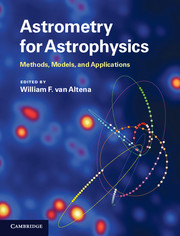Book contents
- Frontmatter
- Contents
- List of contributors
- List of acronyms
- Preface
- Part I Astrometry in the twenty-first century
- Part II Foundations of astrometry and celestial mechanics
- Part III Observing through the atmosphere
- Part IV From detected photons to the celestial sphere
- 13 Geometrical optics and astrometry
- 14 CCD imaging detectors
- 15 Using CCDs in the time-delay integration mode
- 16 Statistical astrometry
- 17 Analyzing poorly sampled images: HST imaging astrometry
- 18 Image deconvolution
- 19 From measures to celestial coordinates
- 20 Astrometric catalogs: concept, history, and necessity
- 21 Trigonometric parallaxes
- Part V Applications of astrometry to topics in astrophysics
- Index
- References
21 - Trigonometric parallaxes
from Part IV - From detected photons to the celestial sphere
Published online by Cambridge University Press: 05 December 2012
- Frontmatter
- Contents
- List of contributors
- List of acronyms
- Preface
- Part I Astrometry in the twenty-first century
- Part II Foundations of astrometry and celestial mechanics
- Part III Observing through the atmosphere
- Part IV From detected photons to the celestial sphere
- 13 Geometrical optics and astrometry
- 14 CCD imaging detectors
- 15 Using CCDs in the time-delay integration mode
- 16 Statistical astrometry
- 17 Analyzing poorly sampled images: HST imaging astrometry
- 18 Image deconvolution
- 19 From measures to celestial coordinates
- 20 Astrometric catalogs: concept, history, and necessity
- 21 Trigonometric parallaxes
- Part V Applications of astrometry to topics in astrophysics
- Index
- References
Summary
Introduction
One consequence of observing from a moving platform is that all objects exhibit parallax. The measurement of parallax yields distance, a quantity useful in astrophysics. In particular, with distance we can determine the absolute magnitude of any object, a primary parameter in two of the most useful “maps” in astronomy: the Hertzsprung–Russell diagram (e.g. Perryman et al. 1997, Fig. 3), showing the relation between absolute magnitude (luminosity) and color (temperature); and the mass–luminosity relation (e.g. Henry 2004, Fig. 3), a tool for turning luminosity into mass, a stellar attribute which determines the past and future aging process for any star. Another example of the utility of absolute magnitudes is the Cepheid period–luminosity relation (PLR). The example used here to illustrate parallax determination had improving that relationship as its ultimate goal.
The technology used to generate parallaxes has proceeded from naked-eye measurements with mechanical micrometers (Bessel 1838), through hand measurements of photographic plates (Booth and Schlesinger 1922), through computer-controlled plate scanners (Auer and van Altena 1978), through computer-controlled CCD cameras (Henry et al. 2006, Harris et al. 2007), through the triumph of the Hipparcos astrometric satellite (Perryman et al. 1997), to space-borne optical interferometers (Benedict et al. 2007, 2009) and extremely long baseline radio interferometers (Reid et al. 2009). Each stage of this historical sequence is characterized by improvements in both the centering of the images of the target and reference stars and the mathematical challenge in distilling the final parallax from those centers.
- Type
- Chapter
- Information
- Astrometry for AstrophysicsMethods, Models, and Applications, pp. 309 - 322Publisher: Cambridge University PressPrint publication year: 2012



